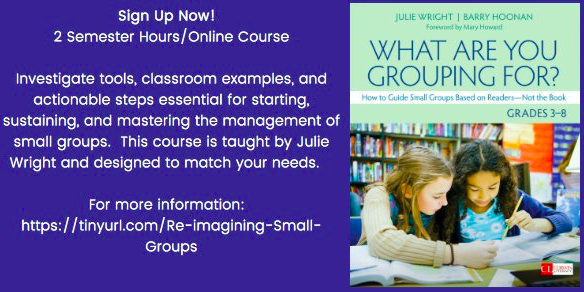Written by Julie Wright & Barry Hoonan
The art of curation is matching texts that will inspire and fuel students’ curiosities with the science of also finding texts that can be used as tools for the content we need to teach. Texts with dual purposes - student interests and content - have big take-aways! When we inch closer to students and pay attention to what they are reading and what they are interested in, we can better collect texts that matter to them and make a bigger difference in their learning.
Let’s call our first move - Curating to Stoke Students’ Interests.
Having the benefit of listening in on our students, we move forward in search of stoking their interests by compiling dynamic texts together. Then we promote ‘their texts’ by displaying them beautifully and giving credit to the students who lifted the topic or inspired the text set. Or, we provide time and space during whole or small group for students to share hot reads or book stacks with peers.
Teaching reading is also grounded in curriculum – skills, strategies, habits and the growing of new ideas. When we curate with curriculum in mind, we like to believe we are standing close to a radiant ideal … that when we spend time learning, that information, knowledge or new idea matters.
So let’s call our second move - Curating Mentor Texts to Teach Something Powerful.
Whether you are a teacher looking for a text to meet a curricular need or selecting one for a read aloud, at heart you are always doing one thing: you are making a choice that will help you teach your kids something powerful. The natural step for finding these texts is to look for favorite and reliable authors. The authors and their works will mentor readers. Readers will feel the power of mentorship. So we lean on these texts as mentors. And we curate with ‘our mentors’ in mind.
In the end, we want our students to “sit around the table” with the likes of Jacqueline Woodson, R.J. Palacio, Angie Thomas, John Green, Matt de le Pena, Jandy Nelson, and Rainbow Rowell -- being wiser and more insightful and more curious than before.
Here’s an example:
Barry’s class has just finished hearing Helen Frost’s powerful prose Hidden read aloud. The sixth graders have discovered from the author’s notes that there is a mystery ‘hidden’ in the last word of each sentence in the second section of the book. It reveals one of the character’s perspectives. They sleuth their way through and read the cryptic message out loud. The class is a buzz.
There are so many possible next steps to capitalize on the students’ enthusiasm for word play. We could curate a text set around books written in prose style, like Witness by Karen Hesse. We could pull together Helen Frost books or even stage a small group to read Hidden again.
Students’ amusement with twisting story plots and fabulous verse opened the chance to stoke their interest in Shakespeare. Using Tales from Shakespeare by Tina Packer made the perfect blend of colorful pictures, great storytelling and some insightful placement of Shakespeare’s own words. And, to capitalize on students’ interests and knowledge of Shakespeare (or lack thereof) Barry asked his kiddos to write on graffiti boards (white paper with color markers) the stories they knew and all the things that came to mind when they thought of Shakespeare and his writing. The colorful boards and conversation danced with questions and ideas such as:
A small group discussed the idea that Shakespeare was a long time ago and people talked really funny then.
Titles like Romeo and Juliet, Hamlet, and Twelfth Night surfaced as other things to read or compare.
A student commented, “Oh no. My brother hated reading Shakespeare in middle school.”
There was a mesmerizing amount of experiences and opinions around the texts being discussed, but very little love toward Shakespeare’s play. Betting on the inertia of word play and misconceptions, Barry began reading ‘Tales’ out loud. Kids were asked to echo lines from the book and together the class engaged and enjoyed Shakespeare’s timeless and relatable stories.
Here’s the interesting part: Choosing the next read aloud is curation at its finest. We want to play to our audience of readers and we want to lift their understanding of humanity, history and themselves. Our end goal is to leave them knowledgeable, inspired, and curious.
For more on teachers and students as curators, see Chapter 7 in our new book!











